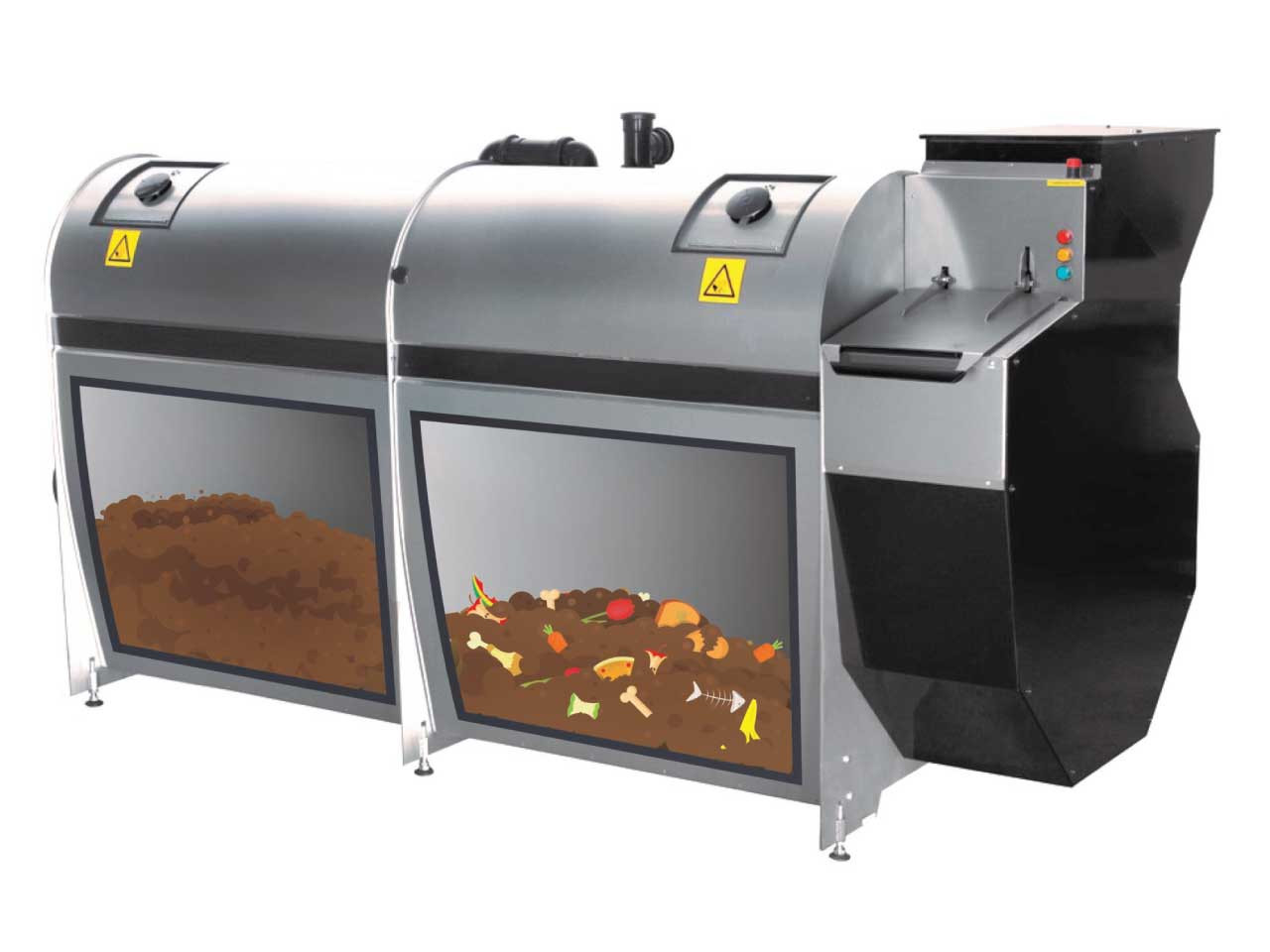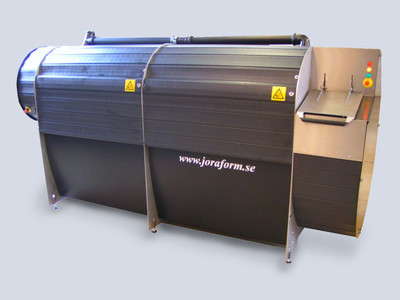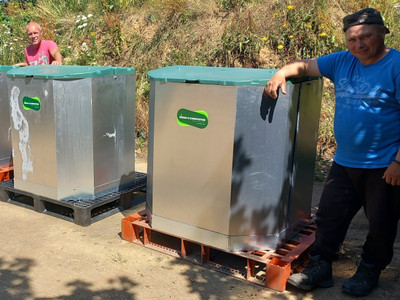Commercial Composting Solutions

Plastic may have taken much of the attention in recent years, but food waste continues to be a pressing issue affecting the environment.
It was estimated by the EPA (Environmental Protection Agency) that roughly 178,000 tonnes of food waste was generated in Ireland in 2020 by restaurants, hotels, B&Bs, pubs, restaurants, cafes, takeaways and canteens. Another recent report found that over 66% of food waste from the food services sector was avoidable.

When this food waste ends up in landfills, it emits large amounts of methane: a very potent greenhouse gas. The Environmental Defence Fund states that at least 25% of today’s global warming is driven by methane from human actions.
When it comes to the household or the individual, things may seem relatively simple: if you’re keen on gardening, it’s almost second nature to separate your food waste into a compost bin and make good use of it. Alternatively, you can separate your organic waste into a brown bin for collection.

However in the case of restaurants, hotels, schools, colleges and so on, you may well have a larger amount of food waste than you can deal with via the above options. There are also regulations to take into account and abide by for disposing of waste above a certain volume.
Food waste can quickly pile up, whether you’re a catering business or you have a high turnover of visitors or attendees who (being human) need to eat! It can take the form of peelings, leftovers, expired food or improperly prepared food.

Commercial composting methods are intended to deal efficiently with these large volumes of potential waste, while creating rich compost and soil improver at the same time.
The three main options for food waste for a business/institution/premises etc are:
- Collection from a waste collector, who will then either bring it to a facility for composting or export it
- Arrange for their own transport to such a facility
- Use an authorised composting unit to take care of the food waste ‘on-site’.

Commercial Joraform JK6200
View Product
Methods of Composting
The two main methods of commercial composting in Ireland are a) ‘turned windrow’ and b) in-vessel. In terms of availing of commercial composting facilities, you should consult your local authority to see if any are based in your surrounding area.
Windrow Composting
With the former, organic material is placed in a series of long rows where they are regularly turned and aerated by hand or by machinery. Despite being in the open air, these piles will reach very high temperatures in the centre as the material breaks down.

Woodrow composting is a common method used by facilities dealing with a high volume of organic waste: the windrows can be several feet high and hundreds of feet long. Windrow composting is regarded as one of the best methods for industrial or municipal composting. However when dealing with food waste this method can attract vermin, so it requires a carefully controlled system.
In-Vessel Composting
As you may have guessed, in-vessel commercial composting is where you place organic waste in a purpose-built sealed container. In-vessel composting takes place at waste facilities, but it is also an option for an individual business or premises to set up their
own system on-site.

Ridan Pro 400 Composter
View ProductThe enclosed, sealed nature of these units contains odours and ensures that they won't attract rodents or vermin. They are a practical and economic alternative to having your food waste collected or transported elsewhere.
Joraform Commercial Composters
Joraform's commercial composting systems enable large-scale processing of food waste. With the addition of a JK6200 or its smaller cousin the JK5100, a business can become self-sufficient in how it deals with its own waste. These units include a built in grinder, automated wood pellet feed (to add carbon) and an aerator fan.
The end product is a nutrient-rich compost which can be used in landscaping or for growing food crops. It's a true closed-loop food recycling system.

Commercial Joraform JK5100
View Product
How Does It Work?
The JK5100 uses a twin-chamber system to process organic waste. It can process 20 tonnes of food waste in a year, while its larger brother the JK 6200 is capable of dealing with twice that: equivalent to approximately 150 households.
Food and organic waste is added to the composter via a chute (or ‘hopper’ as it’s called) with an integrated grinder/shredder. The grinder ensures that the material has an even consistency as it enters the first chamber. This chamber is where most of the active breaking down of material occurs.

Sawdust pellets (similar to those used in a wood pellet boiler) are automatically mixed at the correct ratio to balance the high nitrogen food scraps with a high carbon material, leading to rapid composting. These pellets also reduce odours.
Mechanical arms periodically rotate the composter, airing the mixture and speeding up the decomposition process. Fresh organic material can still be added while this is going on, further fuelling the action. With these sealed biodigesters you can safely add raw or cooked food waste, including meat and fish.
After two weeks the mixture is then ejected into the second chamber. This is known as the ‘ripening chamber’ and has its own separate mixing process. The material at this point should be well broken down (yes, it’s a speedy process!), but separating it from further incoming waste gives it time to further ’ripen’ as it’s kept separate from incoming waste.
Grinding, mixing and aeration operations are variable and can be adjusted using a control panel. You can also get a view of what’s going on inside by using built-in inspection hatches. In total the turnaround from waste disposal to rich compost is a brisk 4 weeks.

Example: The Jk5100 in Action
Laois County Council provided details of a case study where they implemented an automated commercial composter to deal with the ‘significant waste generation’ from the hundreds of visitors they served a day in their canteen. The composter in question was a Joraform JK5100.
By doing this, they reduced the amount of biodegradable waste being sent to landfill, while the resulting compost has been used by the county horticulturist in green areas and parks. Analysis of the produced compost found it "rich in potash and potassium and...therefore suitable for use in vegetable gardens, around fruit trees as well as window boxes".

Example: Cork Urban Soil Project
Recently featured on RTE's Nationwide programme, the Cork Urban Soil Project is an inspiring, community-focused venture that converts urban food waste into nutritious soil. One of the founders is Virginia O'Gara, who is also owner of 'My Goodness Food', a manufacturer and purveyor of many fine foodstuffs including sauerkraut, kimchi and a fermented kefir made from filtered rainwater.
Part of the ethos behind My Goodness was to end up with as little waste as possible both from a packaging and food point of view. Sauerkrauts and kimchis come in recyclable glass jars while their kefir is decanted into champagne grade bottles which, when returned, yield a 50 cent deposit.

Food waste is also kept to a minimum with every single usable scrap going into pickles, preserves or ferments but, as with any food producing endeavour, there will still be a significant amount of waste that can't be used in the kitchen.
The Urban Soil Project believes that food waste is a treasured resource. Waste from My Goodness Food and other Cork businesses (including the Franciscan Well Brewery, whose beer mats go into the mix) is processed by a Joraform JK 5100 biodigester, which turns it into crumbly compost in 4 weeks.

Refurbished Commercial Joraform JK5100
View ProductAfter a further maturation period outside the machine, the finished compost is transferred to raised beds at the CUSP premises and used to grow fresh flowers, herbs and vegetables that become staples in the My Goodness kitchen, thus neatly closing the recycling loop.
What are the Benefits of Using a Commercial Composter?
- The end result of commercial composting is a rich, soil-like material that can be used as soil fertiliser or mulch - whether it’s fed back into the business itself (if the business produces its own food) or supplied to local farmers, landscapers, or nurseries. This material nourishes crops and soil, providing a range of nutrients and leading to higher yields.
- Of course, it also means that food waste is kept out of landfill and methane emissions are thus reduced.
- Due to the amount of material that the Jora can ‘digest’, you can considerably reduce the amount of waste going into other containers, as well as the associated pickup or disposal costs.
- Additional revenue can be created by supplying the finished product to interested parties such as gardeners, horticulturists etc.
- On-site composting will contribute to the sustainability of your business. Sustainability is a concept or practice that encompasses the overall way that your business is run and the impact you have on the environment, the economy and society. When you think about it, carrying out your own commercial composting is a textbook example of this: there’s less food waste (environment), the economic burden of waste disposal is lessened (economy), and local farmers, landscapers etc can benefit from the finished product (social).

Joraform Compost Tumbler JK400
View Product
The Joraform JK400
Smaller restaurants and premises can also consider the Joraform JK400. This is an insulated and sealed rotating composter with two chambers. The inner temperature can reach 75°C, which allows for rapid active composting. The second chamber allows compost to mature while fresh organic waste is being added to the first chamber.
The JK400 is easy to rotate and has built-in vents which ensure that plenty of air is added to the mixture. It can process from 50-80 litres of compost a week, or almost 2 tonnes annually. All in all you can have finished compost in just 6-8 weeks.

Ridan Pro 200 Composter
View Product
Ridan Composters
In comparison to the Joraform biodigesters, Ridan's composters are a little less automated and can require a bit more monitoring. They are very easy to use though, as you simply turn a handle on the outside of the unit to aerate the organic mixture inside.
The Ridan utilises a two stage composting process. The first stage involves adding food and garden waste to the insulated composter pictured above. You can do this using the hatch, which also provides vital airflow. The inner temperature will rise (as high as 60°C) as more material is added and microorganisms break it down. In optimum conditions, bacterial colonies can double every hour.

This first stage is known as the 'active' or hot composting stage; the material that emerges from the composter after this process will be thoroughly mixed, aerated and populated with composting microbes. It won't be finished compost, however: here is where Stage 2 comes in, or the maturation stage.
At this point the mixture is added to a Ridan Pro Maturation bin - which has a capacity of 970 litres - and is left to fully break down. This bin has a steel base and metal sides to safeguard against rodents. It measures at around a cubic metre overall, which is ideal for keeping the temperature above ambient and allowing the compost to decompose naturally.

Ridan Pro 900 Maturation Bin
View ProductThis maturation process should take at least three months, but as a general rule the longer you leave it the better. It is best to have more than one of these maturation bins, as they can quickly fill up. 3 bins are recommended for the Pro 400 composter and two for the Pro 200.
A Popular Composter for Schools
Case studies and feedback for the Ridan composter feature some very positive reactions from schools and young pupils. At Ardent College in the UK, students refer to the Ridan as the 'dragon' that sits on their rooftop micro-garden. Tutors report that the students feel engaged in the composting process, with the operation of the crank handle giving them direct, tangible involvement.
The addition of an on-site composter can help to educate kids of all ages about environmental awareness, reclaiming food waste and the natural life cycle.
Why Sustainability is Important
Pursuing sustainability may seem more like an obligation than a benefit, but make no mistake: sustainability is increasingly an asset to a business, resulting in a positive reputation, good social connections, future-proofing against regulations further down the line etc.

Many consumers are looking for businesses that care about their social and environmental impact, and will gravitate towards the ones that ‘walk the walk’ so to speak.
If you’re interested in the Joraform commercial composter, you can contact Niall at: niall@quickcrop.com for further info. We can also provide assistance with grant applications to make the JK composter a more affordable solution for your business.




